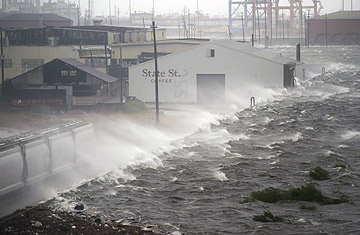
Water sloshes over the side of a levee on the Industrial Canal in New Orleans, Louisiana, on September 1, 2008 due to Hurricane Gustav.
The wind continues to howl in New Orleans though the rain is coming in patches. A few fences are down but there is no sign of large-scale flooding — yet. However, just before noon, Maj. Tim Kurgan, spokesman for the Army Corps of Engineers' New Orleans district, said there was "overtopping" (that is, spilling over) on the western side of the Industrial Canal which has three main tributaries: Lake Pontchartrain, the Intercoastal Water Way, and the Mississippi River-Gulf Outlet, commonly known as "Mr. Go." Gustav's heavy winds have apparently pushed water into the Industrial Canal from those three areas. Kurgan said the last reading on the Industrial Canal's gauge was 11.83 feet; the lowest wall along the canal is about 12.12 feet.
Among the communities threatened by the overtopping of the Industrial Canal are the Gentilly neighborhood, a leafy, middle-class neighborhood that was among the most severely hit by Hurricane Katrina's floodwaters. It sits on the western side of the Industrial Canal, just south of Lake Pontchartrain. Also at risk, just to the south, is the Bywater neighborhood, which sits where the Mississippi River meets the Industrial Canal. "With the amount of water coming over right now, if you combine that with the heavy rainfall, you'll have some significant inundation," Kurgan said.
So far, he said, there have been no flooding in the Lower Ninth Ward. During Katrina, a barge pierced the Industrial Canal's levee, flooding the Lower Ninth Ward. Since then, the Corps has built 15-foot-high walls — which it calls "T-Walls" — made of concrete. Other points in the region vulnerable to flooding are St. Bernard Parish, just south and east of the Lower Ninth Ward, and Houma, near where Gustav landed.
Earlier in the morning, the wind pounded the rain into the windows of my hotel room in Metairie, down the highway from New Orleans on Lake Pontchartrain. You could barely see out the windows, the wind was so strong. Just a few minutes earlier, the branches of trees were barely moving. It's certainly a strong storm, but not nearly as powerful as folks feared. And so Gustav arrived with a somewhat diminished bang, the first bands striking just before midnight. For much of Sunday evening, the city, and region, had been bathed in the odd silence that usually precedes hurricanes. As the wind quickened, the street lights shook.
Now, however, the authorities don't seem to be concerned about Gustav itself, given how much it has diminished. But the authorities are still concerned about the surge of water Gustav will likely send into low-lying costal areas, where many residents apparently refused to leave. Water is already being reported surging in Louisiana's boot. The surge is also expected to send several feet of water into the west bank of New Orleans' suburbs.
There's also the political hazards of Gustav. At least one Democratic politician got himself into trouble trying to read divine intervention into the timing of Gustav's landfall. It was certainly remarkable, coming nearly three years after Hurricane Katrina, and on the eve of the Republican National Convention's scheduled opening, which has been scrambled and diminised by the storm. Gustav's arrival was heralded with a kind of grandeur: the city's mayor, C. Ray Nagin, pronounced it "the storm of the century," a declaration that seems to have had remarkable success in a region that once stared down hurricanes with a beer. Nearly 1.9 million residents of Louisiana's lower tier fled. Still, there's a chance this could have all been an expensive exercise, a chance for state and local authorities to prove they could actually coordinate a plan. The political accounting for that may take weeks to accumulate.
Don Jacks, a FEMA spokesman, last night said some 2,114 people had been moved from New Orleans by train alone in the days before the storm. The coordination began in earnest with people registering on a 311 telephone system reporting they had no tangible means of evacuating. They were directed to a meeting point in the city, and then brought to either the downtown New Orleans bus-train station, or airport. There, residents were placed through the standard security measures with Transportation and Security Administration officials. Special care was made to keep families together, Jacks said. In the end, nearly 6,400 people left on some 2,054 flights. It's unclear whether people knew where, exactly, their planes were bound.
The most vivid reflection of Katrina's lessons was on the streets of New Orleans. Barely a soul walked the streets last night. Even Bourbon Street's pubs were shuttered. Network television satellite trucks were perched perfectly across Jackson Square. Nearby, photographers positioned themselves in front of a Cafe du Monde that lacked both chairs and the famous beignets. Elsewhere in the city, New Orleans evacuees had put their cars on the "neutral ground," as the space between the lanes of streets is called here, hoping that might save their vehicles from flooding. Never mind that the patch of land is barely a half-foot above ground. Perhaps the liveliest discussion came on the radio airwaves, where several callers cast their decision to stay as a battle of man versus nature. Meanwhile, residents of the seemingly flood-resistant Uptown neighborhood, defied Gustav from their porches, comfortable above the police officers patrolling below.
